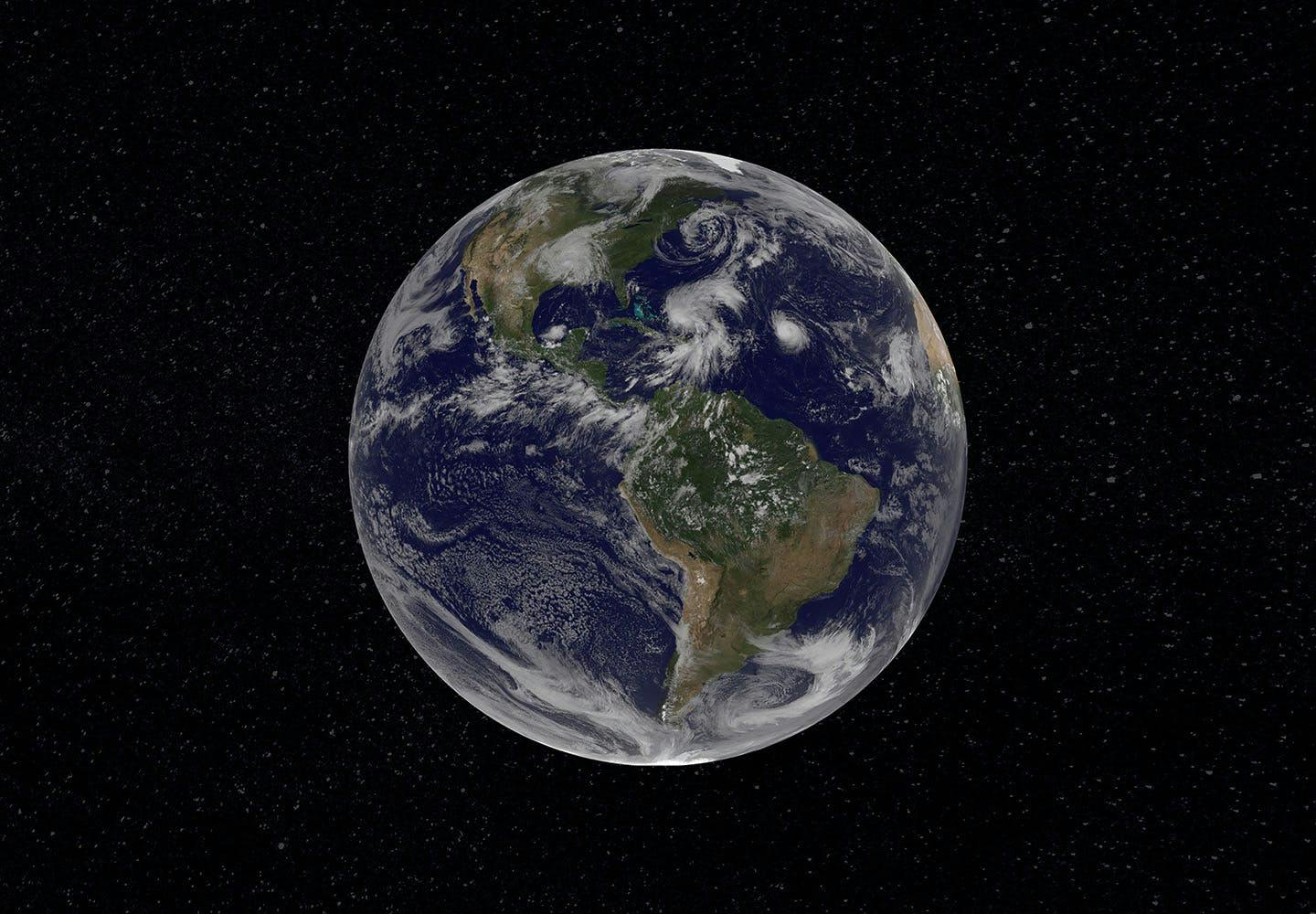Below 1.5ºC: a breakthrough roadmap to solve the climate crisis
A state-of-the-art climate model released by the prestigious scientific publisher Springer Nature offers a roadmap for meeting -- and surpassing -- the targets set by the Paris Climate Agreement, showing that we can solve the global climate crisis with currently available technologies and natural climate solutions. The book, entitled Achieving the Paris Climate Agreement, was the culmination of a two-year collaboration with 17 leading scientists at the University of Technology Sydney (UTS), two institutes at the German Aerospace Center (DLR), and the University of Melbourne’s Climate & Energy College.
As the Intergovernmental Panel on Climate Change (IPCC) warned in its Special Report on Global Warming of 1.5°C (SR1.5) released October 2018, the Earth must be kept below the dangerous threshold of 1.5°C in global average temperature rise above pre-industrial levels if we are to avoid a worsening of climate-related impacts. We are already seeing the devastating consequences of the current 1°C global temperature increase, including rising sea levels in many coastal cities, extreme storms, prolonged droughts, and intensified wildfires.
The impacts resulting from higher temperatures are almost unimaginable -- the death of the coral reefs in every ocean, the collapse of nearly one-quarter of the world’s agricultural land, dramatically increased heat waves and wildfires, 100 million people driven to extreme poverty sparking multiple refugee crises, 1 meter of sea level rise in some regions, and more than $11 trillion per year in damages from extreme storms and flooding. Stacked upon each other, these impacts and many more, could undermine the very fabric of life on our planet, greatly challenging the continuation of human civilization as we currently know it.
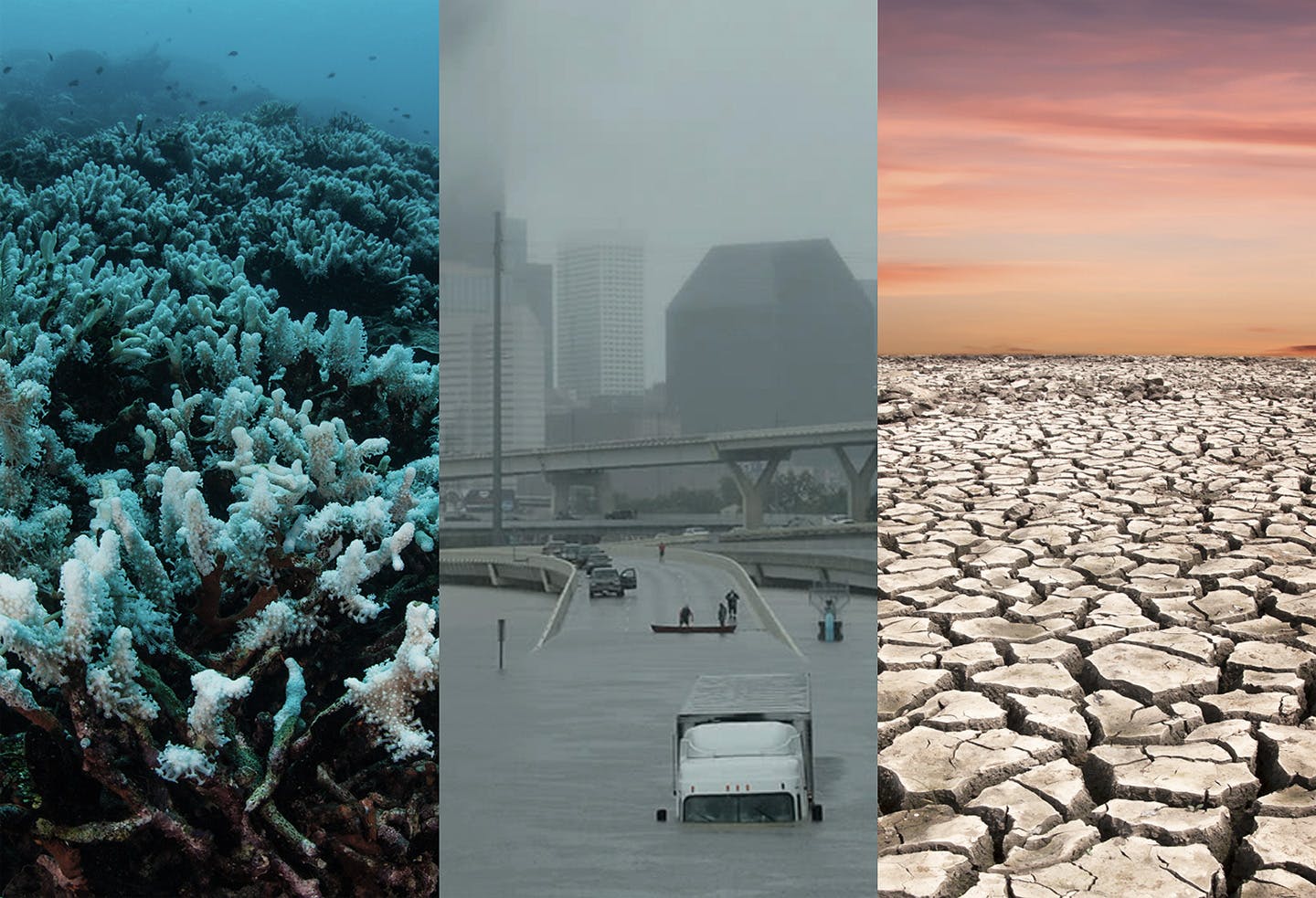
The death of coral reefs, extreme flooding, and desertification are all likely climate impacts under 2˚C of temperature rise.
Up until now, it was assumed to be difficult, if not impossible, to achieve the carbon budget required to stay below 1.5˚C – a maximum of 400 billion tonnes of cumulative carbon dioxide emissions (GtCO2) from January 2018 on. Humans today release approximately 39 GtCO2 per year, mostly from the burning of fossil fuels -- coal, oil, and natural gas. At our current level of emissions, we would only have 7 years to completely cease the use of all fossil fuels, which is clearly not feasible. While many scientists have modeled 1.5°C climate mitigation pathways, to make the math work almost all of them require the use of unproven and potentially dangerous geoengineering strategies like Solar Radiation Management (SRM) or Bio-energy with Carbon Capture & Storage (BECCS).
The 1.5ºC climate model is groundbreaking in that it shows the 1.5°C target can be achieved through a rapid transition to 100% renewables by 2050 (56% by 2030), alongside a major conservation effort to increase the resilience of natural ecosystems and help ensure greater food security. This includes a moratorium on land conversions by 2030 and 400 GtCO2 of ‘negative emissions’ from forest and land restoration (shown in gold below the zero line), which pulls carbon dioxide out of atmosphere and stores it in trees and soil.
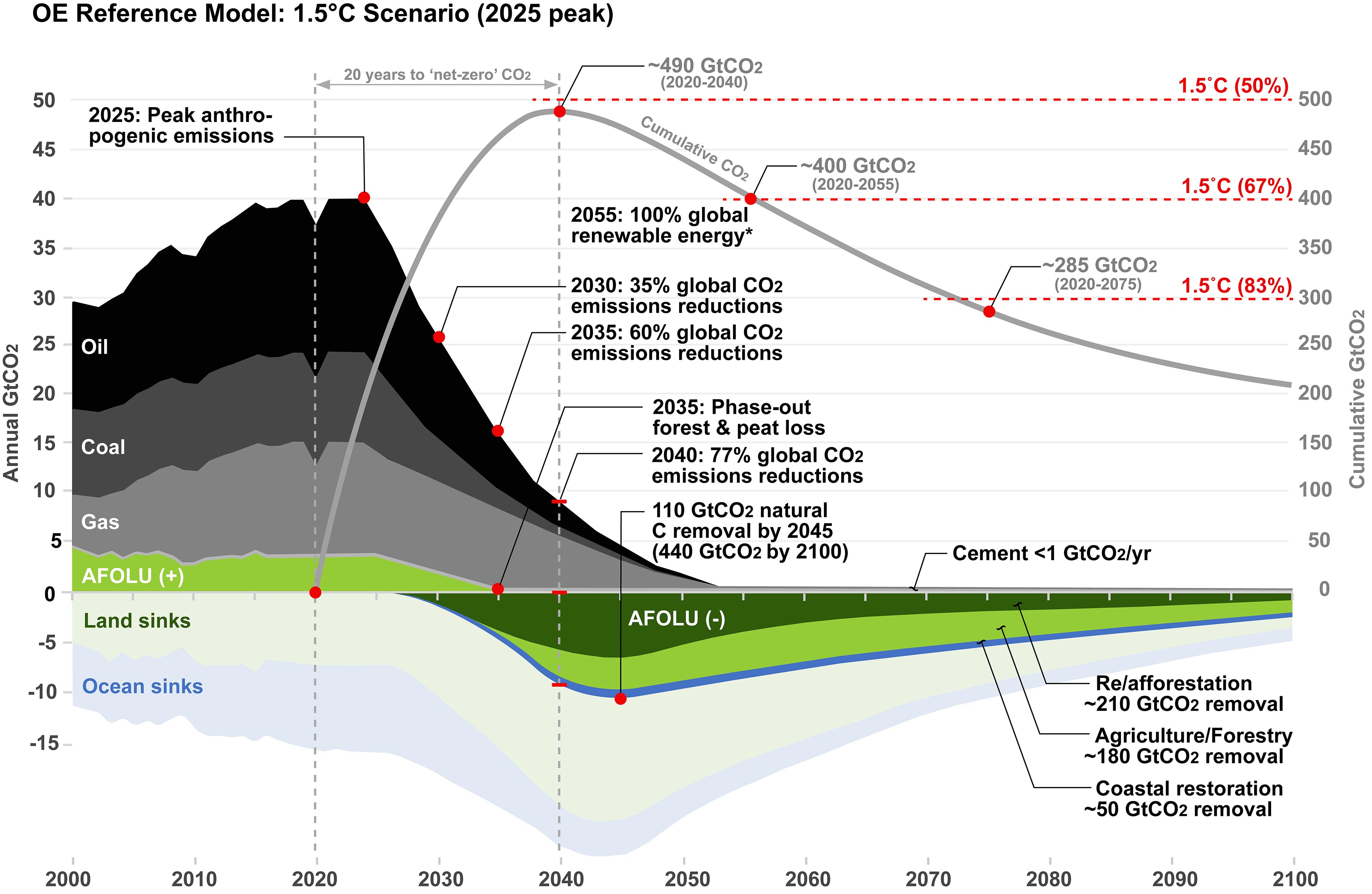
The One Earth Reference Model, updated in 2022, limits global average temperature to 1.5°C above early industrial levels (c.1850-1900) with a peak in cumulative anthropogenic emissions of approximately 500 GtCO2 in 2045 (above 2020 levels). This is achieved by (1) a rapid reduction in fossil fuel emissions (black) with approximately 50% of projected energy demand met through renewables by 2035 and 100% renewable energy across all sectors by 2055*; (2) a full phaseout of deforestation and peat loss by 2035 with ongoing net-zero emissions from all other land uses (such as agriculture and forestry); and (3) approximately 110 GtCO2 of carbon removal by 2045 and 450 GtCO2 by 2100 from 11 ecosystem restoration pathways (green and blue). The model relies upon a rapid reduction of both methane and nitrous oxide emissions by 2040 -- one-half and one-third respectively. *100RE excludes direct emissions from cement production and some industrial processes, totaling < 1 GtCO2/yr. The greenhouse gas scenario was run with MAGICC7, a prime reduced-complexity model to determine radiative forcing and projected global temperature rise, based on IMAGE quantification of the SSP1-Baseline scenario in the IPCC SR1.5 database. The model projects that natural land carbon sinks (light green) and ocean carbon sinks (light blue) continue to function through 2100, but decline in the second half of the century. The energy decarbonization scenario is optimized for 72 sub-regions modeled in hourly increments with a final emissions peak in 2025. The results are in alignment with the carbon budgets documented in IPCC’s Sixth Assessment Report (WGI, 2022) -- 500 GtCO2 for a fair chance (50%); 400 GtCO2from 2020 for a good chance (67%); and 300 GtCO2for a near certainty (83%) of limiting warming to 1.5°C. Note: The temporary drop in fossil fuel emissions due to the COVID-19 pandemic appears to occur before 2020 in the scenario timeline. This is due to the standard practice of plotting average annual emissions, rather than monthly emissions, and does not affect the final results.
Co-author and editor Dr. Sven Teske, Research Director of the Institute for Sustainable Futures at the University of Technology Sydney (UTS) said,
Some have doubted that a transition to 100% renewables is even possible. To explore the potential, the scientists at UTS created a sophisticated computer model of the world’s electrical grids to date -- with 10 regional and 72 sub-regional energy grids modeled in hourly increments to the year 2050 along with a comprehensive assessment of available renewable resources like wind and solar, minerals required for manufacturing of components, and configurations for meeting projected energy demand and storage most efficiently for all sectors over the next 30 years.
The result of the modeling effort shows that not only is it possible to switch to 100% renewables for all energy uses, but it will cost much less to operate than today’s energy system. Moreover, it will eliminate the toxic pollution associated with the burning of fossil fuels, estimated to be the primary cause of 9 million premature deaths per year. The renewable energy transition will not only improve public health worldwide, it will also drive economic development, providing the 30 million people currently working in the energy sector with permanent, well-paying jobs and creating an additional 12 million new jobs.
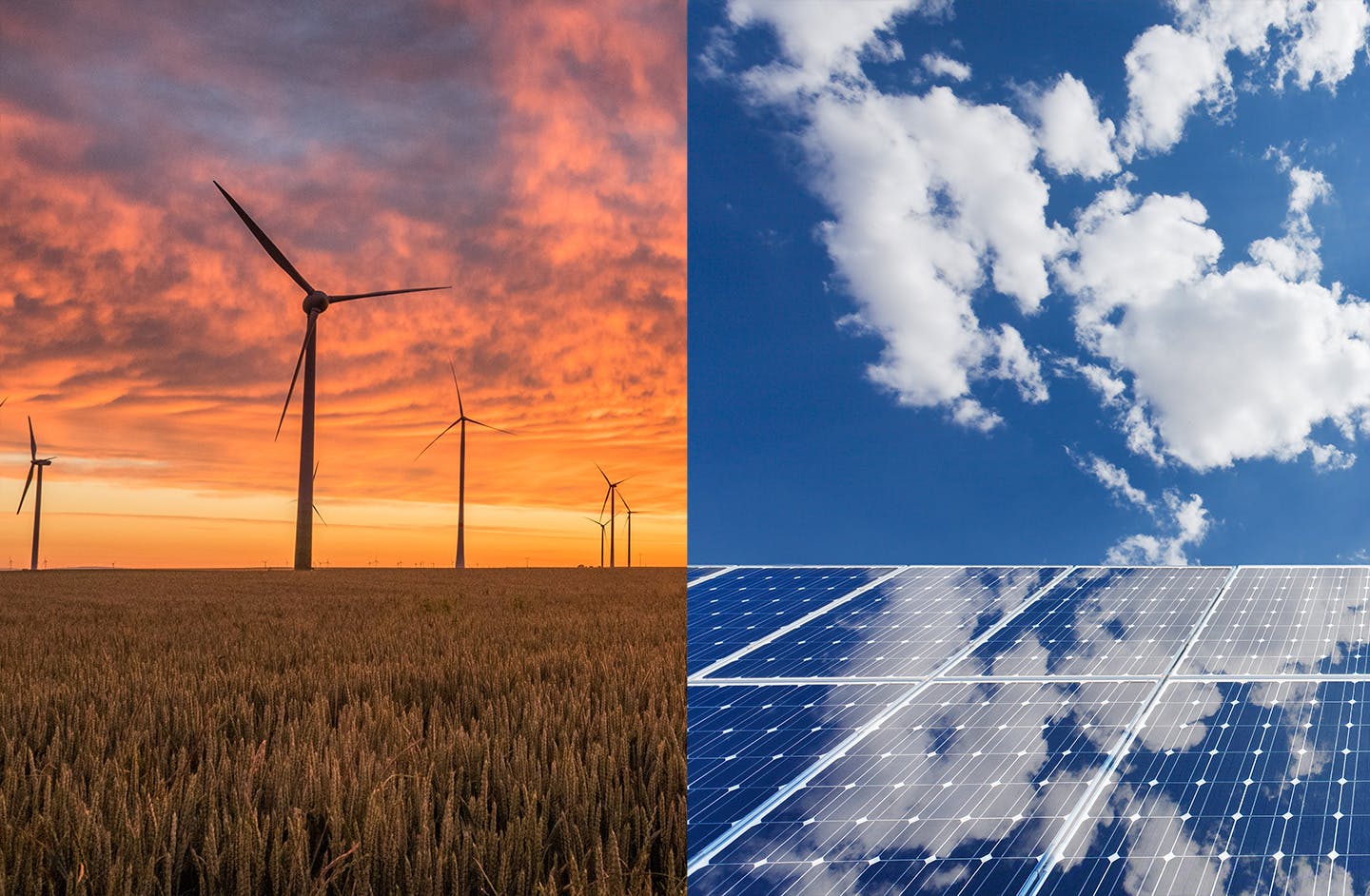
Solar and Wind resources could provide nearly all of our energy needs by the middle of the century, eliminating the need for coal mining and oil & gas drilling.
The proposed energy transition outlined in the 1.5ºC climate model will require an investment globally of approximately $1.7 trillion per year. This sounds like a lot, but it pales in comparison to the vast subsidies governments currently provide to prop up the ailing fossil fuel industry, estimated at more than $4.7 trillion per year by the International Monetary Fund (IMF). Taxpayers are unwittingly funding the climate crisis, and that needs to stop. The research tells us that we could be creating the clean energy future we so desperately need for less than one-third of what we’re spending now, and in so doing improve energy access in the developing world.
Leonardo DiCaprio said:
There are five major components to the renewable energy transition. First is increased capacity to generate electricity mostly through solar and wind power, enabling the electrification of all energy uses including power, heating, transportation, and even industrial uses. Second is increased storage capacity in the form of battery arrays and pumped hydroelectric (which uses excess generation to pump water up to a reservoir releasing the energy when needed). Third is energy efficiency – decreasing overall energy consumption, especially in the developed world, by making buildings, cities, and vehicles more efficient. Fourth involves repurposing the existing gas pipeline and storage infrastructure to deliver hydrogen produced by renewable sources. And fifth is a gradual retraining of the energy workforce to participate in the burgeoning green economy.
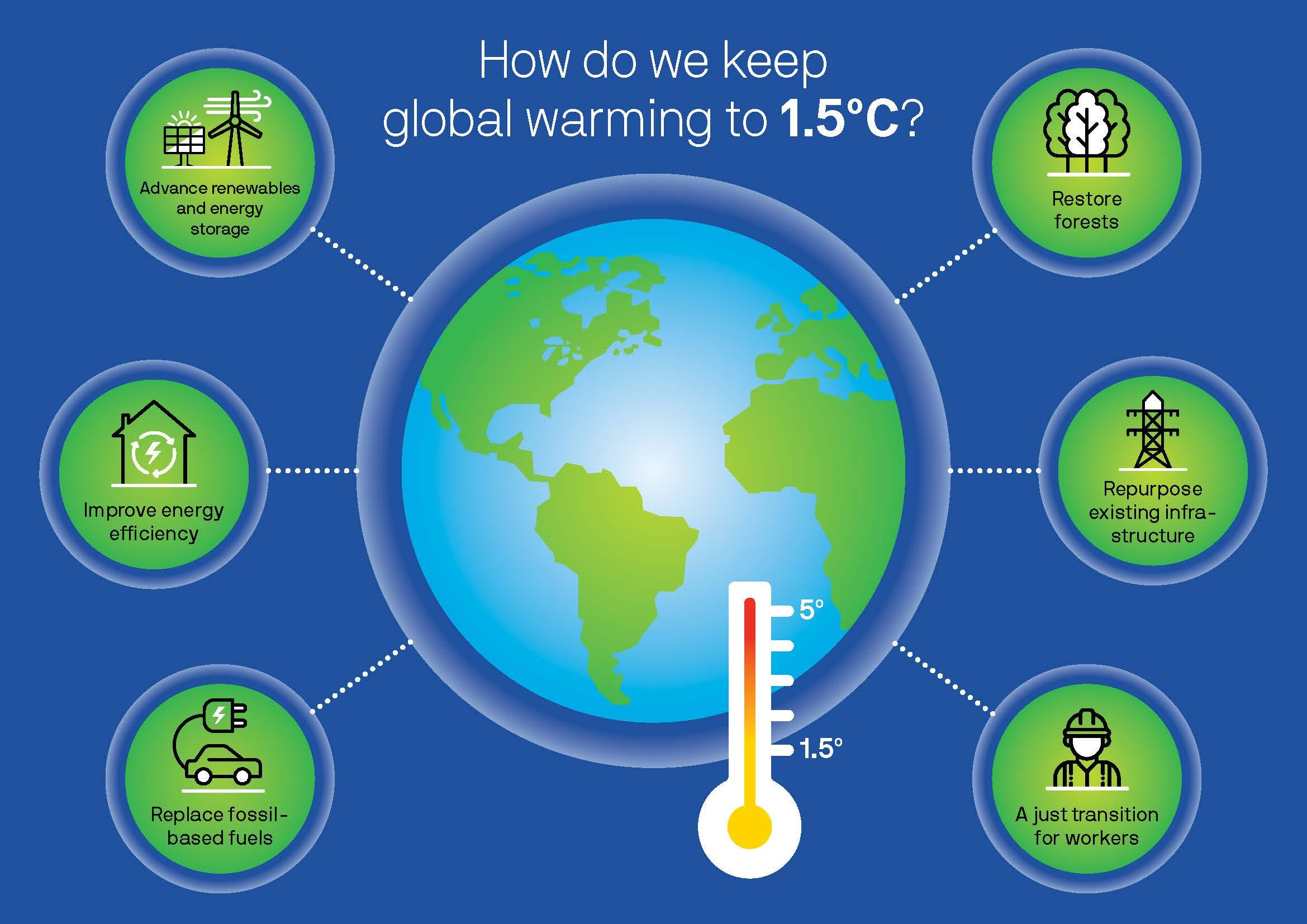
Six components are needed to achieve the 1.5˚C climate target. Courtesy of Springer Nature.
The sixth major component of the climate model is land restoration. “Citing a growing body of research, we show that using land restoration efforts to meet negative emissions requirements, along with a transition to 100% renewable energy by 2050, give the world a good chance of staying below the 1.5°C target,” said Malte Meinshausen, co-author, Founding Director of the Climate and Energy College at the University of Melbourne and Potsdam Institute Fellow.
Natural Climate Solutions (NCS) include everything from restoring natural forests, grasslands, and wetlands to improving soil fertility through regenerative agricultural practices like agroforestry, silvopasture, and cover crops. These solutions not only absorb carbon, they also dramatically increase sustainable livelihoods in the developing world, offering improved water supplies, reduced soil erosion, and higher quality crop yields.
The 1.5C model shows just how important our natural ecosystems are. Karl Burkart, Managing Director of One Earth, said,

Forests and wildlands absorb approximately one-quarter of human-caused carbon dioxide (CO2) emissions.
The land use sector should be a big part of the climate solution. Unfortunately, because of rampant deforestation and unsustainable industrial agriculture and livestock practices, it is a net emitter of greenhouse gas pollution. Many efforts, like the New York Declaration on Forests, is working to halt deforestation by 2030, and UN Sustainable Development Goal 15 calls ending to this destructive practice. The climate model shows that by protecting natural ecosystems and completely phasing out deforestation in the 2030’s, we can maintain the integrity of the carbon sinks that are so vital to rebalancing our global climate system.
The newly released climate model is part of the larger One Earth initiative which builds upon the latest science to create a vision for the world that is possible in 2050, a world in which humanity and nature can coexist and thrive together. The vision is based upon three pillars of action – 100% renewable energy, the protection and restoration of 50% of the world’s lands and oceans, and a transition to regenerative agriculture. Together, these pillars of action give us a global roadmap to tackle the climate crisis and to ensure a sustainable future for all of Earth’s inhabitants.
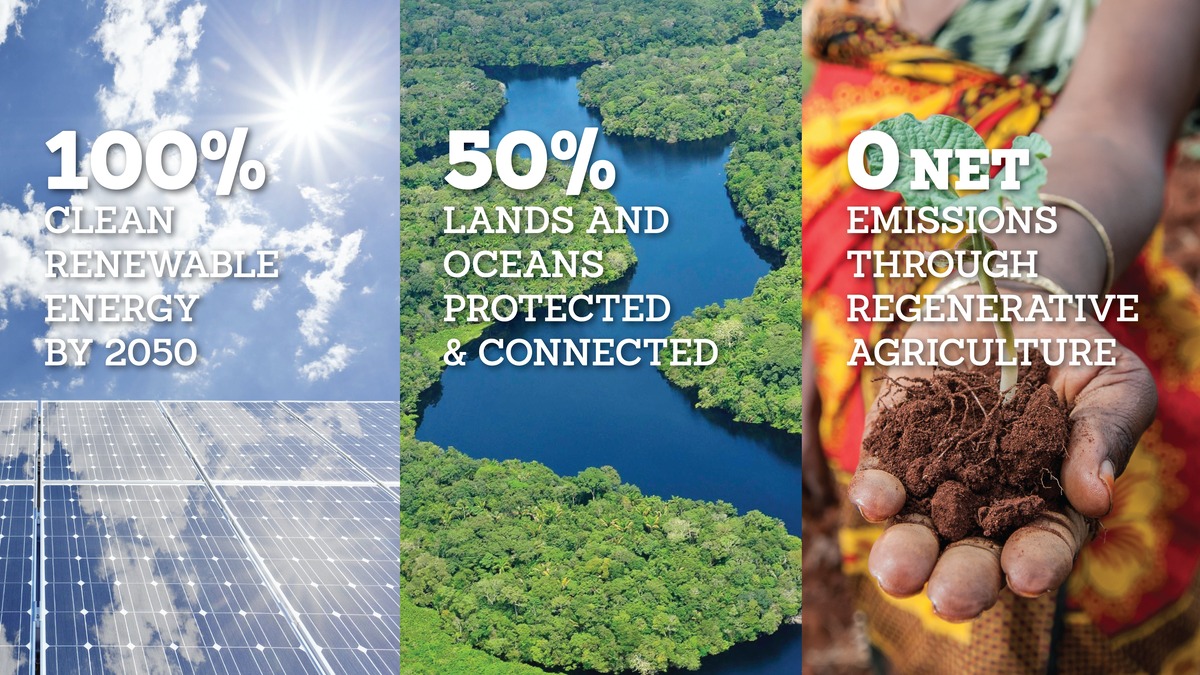
The One Earth Reference Case
After 20 years of negotiations, the world’s governments came together under the United Nations Framework Convention on Climate Change (UNFCC) and established the Paris Climate Agreement in 2015 (COP25). They created a structure in which countries could submit pledges, called Nationally Determined Commitments (NDCs), that would be added together to achieve the target of staying “well below 2˚C” in global average temperature rise, with the goal of gradually increasing commitments over time. Despite Trump’s move to increase fossil fuel production in the United States and his stated “pull-out” from the Paris Agreement, current global emissions are actually leveling off. In 2017 emissions were about 39 GtCO2 per year, and emissions could peak by 2020 according to many experts.

Climate negotiators announce the Paris Climate Agreement in 2015.
While the Paris Climate Agreement was a success in many ways, it’s very clear that it will not deliver what is needed to achieve reductions sufficient to avoid a climate crisis. The latest analysis of government commitments by Climate Action Tracker estimates the current pledges would result in about 2.85˚C of global temperature rise. There is hope, however, in the next commitment period that pledges will increase, as the world wakes up to the disastrous impacts of our current level of warming. So for the purposes of an optimistic “reference case” scenario, One Earth uses the midline between current pledges and what is needed to achieve 1.5˚C:
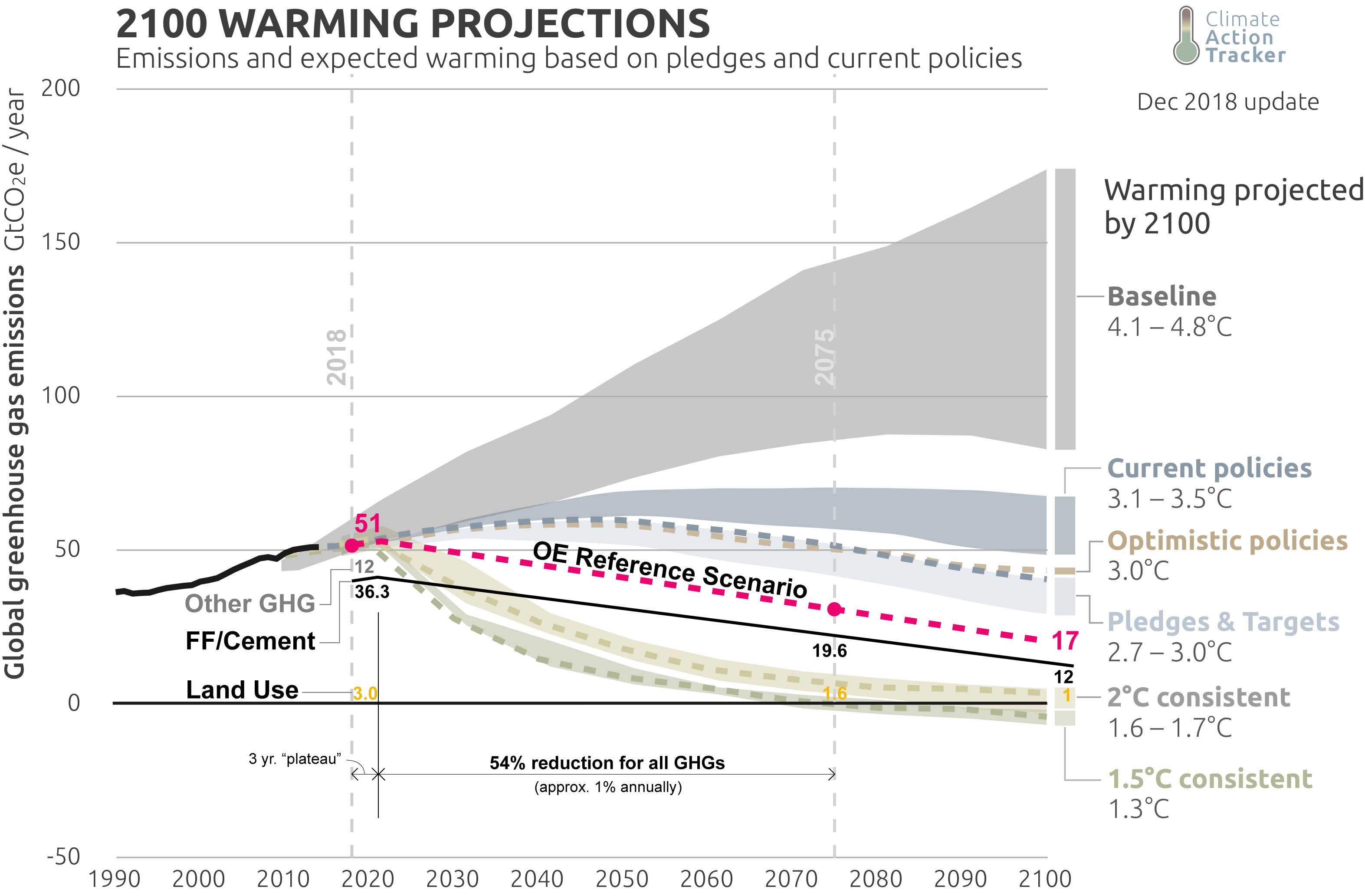
The reference case factors in a plateau period between 2018-2020 of an average of 39 GtCO2 per year, and then a linear reduction in CO2 at approximately 1% per year between 2021-2075. The resulting cumulative emissions of the OE reference case are approximately 1750 GtCO2 emissions total, less 1175 GtCO2 from avoided FF emissions, with approximately 100 GtCO2 in avoided land use emissions and 275 GtCO2 in negative emissions from reforestation & 25 GtCO2 negative emissions from agroforestry. Another 175 GtCO2 is possible in negative emissions from the agricultural sector could bring us back to 2018 levels by end of century.
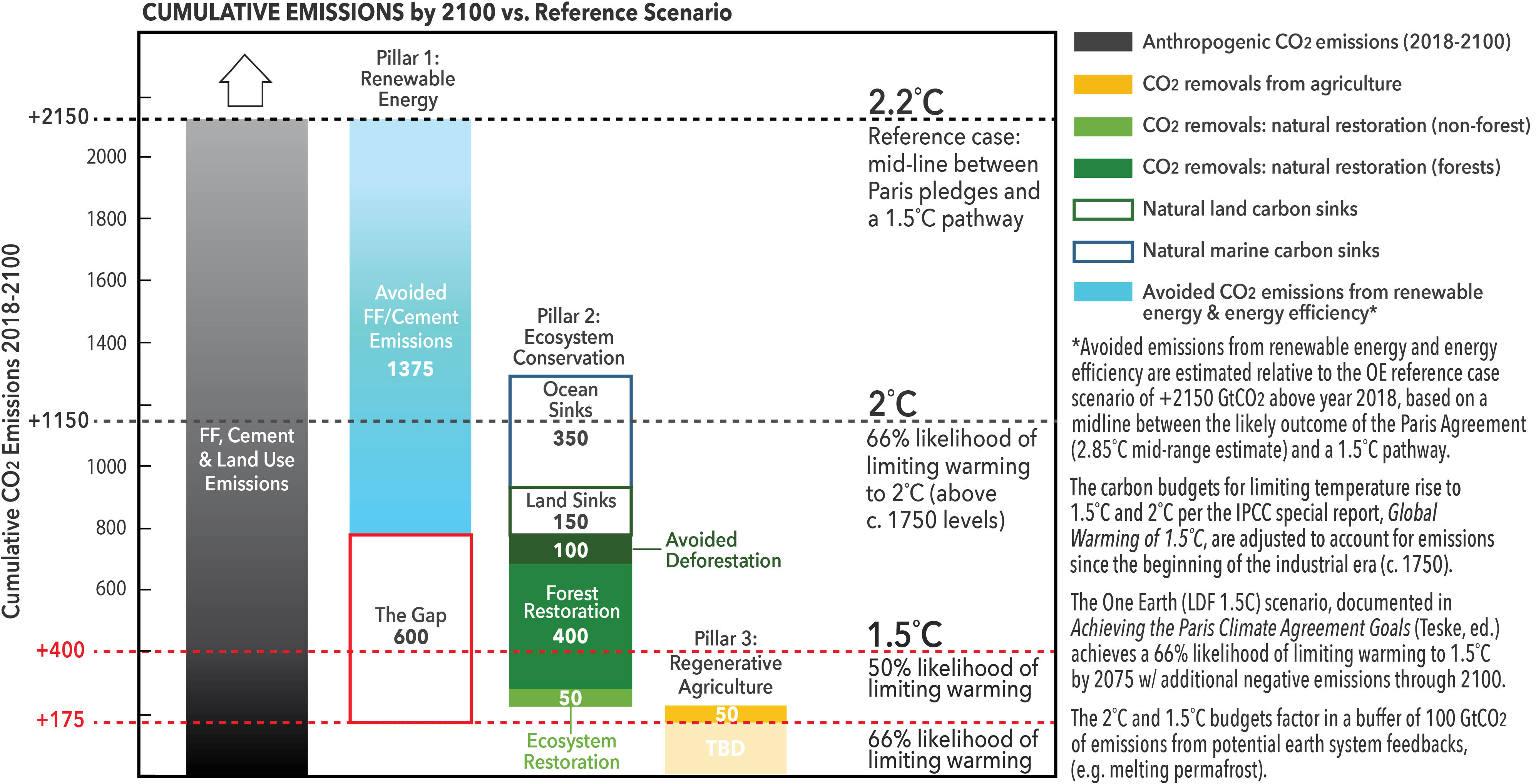
3 pillars of climate mitigation with total avoided and removed carbon emissions by 2100. In the One Earth climate mitigation scenario, a rapid decline in fossil fuels avoids approximately 1375 GtCO2 (pillar 1) versus a reference scenario of 2150 GtCO2, which uses a start point of January 2018 and assumes all current pledges under the Paris Agreement are achieved. A gap of 600 GtCO2 remains to achieve a good (66%) chance of limiting global temperature rise to 1.5°C. Approximately 550 GtCO2 of nature-based mitigation (pillar 2) can be achieved through avoided deforestation (100 GtCO2), carbon removal from forest restoration (400 GtCO2), and other ecosystem restoration efforts (50 GtCO2). The remaining gap of 50 GtCO2 to achieve the 1.5°C goal can be closed through afforestation on croplands and rangelands. A technical potential of at least 150-200 GtCO2 of additional carbon removal from soil carbon sequestration has been identified, but further research is required to understand the full potential of regenerative agriculture practices (pilar 3). Credit: Karl Burkart, One Earth
It’s clear that all 3 pillars of action are required to achieve the goal of limiting warming below 1.5˚C. A transition to 100% renewables by 2050, while incredibly aggressive, is not sufficient to get to a low (50%) likelihood of the target, much less a strong (67%) likelihood. Environmental conservation, which avoids approximately 100 GtCO2 of emissions from land use change relative to the reference case, plus 275 GtCO2 in negative emissions from environmental restoration gets us very close to the goal, but it takes an additional 25 GtCO2 in negative emissions from the agriculture sector to actually get to a strong likelihood of staying below 1.5˚C.
Learn more by reading about the 3 pillars of action derived from the 1.5ºC climate model -- 100% Renewable Energy, Nature Conservation, and Regenerative Agriculture.
Download the Executive Briefing.
.
